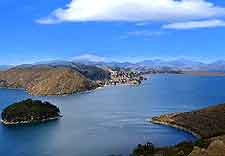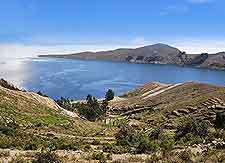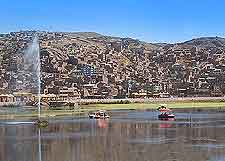Juliaca - Lake Titicaca
(Juliaca, Puno, Peru)

Located just minutes from the north-westerly shore of Lake Titicaca, Juliaca is well placed for those planning to pay Lake Titicaca a visit. In fact, it is often the allure of Lake Titicaca and its past ancient civilisations that is the reason why such a wealth of seasonal tourists choose to stay in Juliaca.
The Pukara culture first arrived in this part of
Peru more than 2,200 years ago and erected a series of pyramids, being followed several centuries later by the Tiahuanaco culture, who based themselves around the neighbouring border with Bolivia. Today, Lake Titicaca remains an integral part of Peruvian life and is surrounded by appealing lakeside communities, where folklore festivals, traditional music and dancing, and local handicrafts are amongst the main attractions.

General Information
Currently the highest navigable lake in existence, Lake Titicaca also serves as the biggest lake in the whole of South America, stretching for some 170 km / 106 miles in length and just over 60 km / 37 miles in width.
Various passenger boats are on hand, to transport tourists from Juliaca around the lake's shore and provide exceptional vistas of the various lakefront churches and colonial ruins.

Lake Titicaca is known for its beautiful blue colour and exceptionally clear mountain air, and contains a number of interesting islands. These include the very famous Islas Flotantes (Floating Islands), which are within easy reach of Juliaca and particularly close to the Puna harbour.
The man-made Islas Flotantes have become one of the most visited tourist attractions around Lake Titicaca, although the extreme popularity of the islands has led to much commercialisation. Others many prefer the sights on the rather more permanent Isla Amantani, the Isla Suasi and the Isla Taquile.
 Located just minutes from the north-westerly shore of Lake Titicaca, Juliaca is well placed for those planning to pay Lake Titicaca a visit. In fact, it is often the allure of Lake Titicaca and its past ancient civilisations that is the reason why such a wealth of seasonal tourists choose to stay in Juliaca.
Located just minutes from the north-westerly shore of Lake Titicaca, Juliaca is well placed for those planning to pay Lake Titicaca a visit. In fact, it is often the allure of Lake Titicaca and its past ancient civilisations that is the reason why such a wealth of seasonal tourists choose to stay in Juliaca.
 Lake Titicaca is known for its beautiful blue colour and exceptionally clear mountain air, and contains a number of interesting islands. These include the very famous Islas Flotantes (Floating Islands), which are within easy reach of Juliaca and particularly close to the Puna harbour.
Lake Titicaca is known for its beautiful blue colour and exceptionally clear mountain air, and contains a number of interesting islands. These include the very famous Islas Flotantes (Floating Islands), which are within easy reach of Juliaca and particularly close to the Puna harbour.